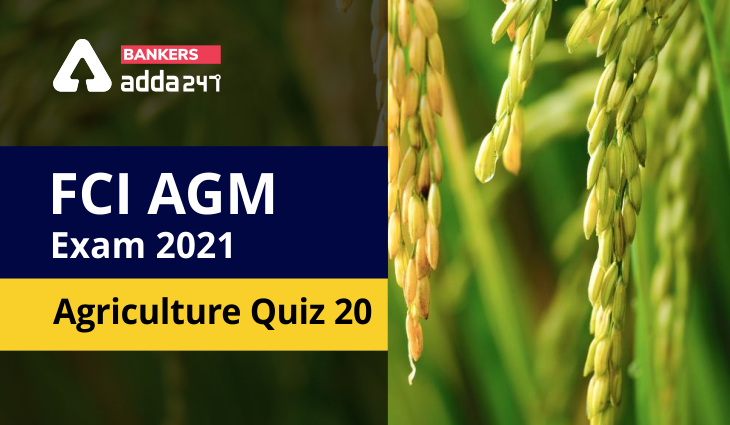FCI Recruitment 2021: Good News for all the aspirants, Bankers Adda team is coming up with Exclusive Questions of Agriculture for FCI AGM 2021 on the Adda247 app also, so download the Adda247 App now to attempt these quizzes. We have started this series on 18th March 2021. So, do attempt it daily from today and crack the FCI AGM 2021 Exam.
Q1. The development of high-yielding-varieties (HYV) of wheat and rice is known as
- Agri (R&D)
- The Green Revolution
- Farming methods
- Agribusiness Revolution
- None of these
Explanation:- The Green Revolution in India refers to a period in India when agriculture was converted into an industrial system due to the adoption of modern methods and technology, such as the use of high-yielding variety (HYV) seeds, tractors, irrigation facilities, pesticides, and fertilizers.
Q2. The greenhouse effect is the phenomenon by which
- Biological diversity is dominant in agricultural production
- The globe’s water pollution affects plankton
- The earth’s atmosphere traps infrared radiation
- Climatic changes occur naturally in the forest
- None of these
Explanation:- The greenhouse effect is a natural phenomenon allowing life to occur on the planet. It is caused by a series of greenhouse gases (water vapor, carbon dioxide, methane and nitrous oxide) that absorb part of the energy, while the remainder escapes into space.
Q3. Low productivity of agriculture in India is not caused by
- Inadequate availability of inputs
- Subdivision of land holdings
- Less area under cultivation
- Poor finance facilities
- None of these
Explanation:- Inadequate means of transport forces the farmers to sell their produce to local money lenders at low prices. Due to a lack of warehousing facilities, farmers can not able to store their produce when prices are low. So these attribute a lot to the low productivity of agriculture.
Q4. Reclamation of alkali soil by use
- Gypsum
- Iron pyrite
- Green manuring
- Only A and B
- All of the above
Explanation:- Reclamation of alkali soils requires the removal of exchangeable sodium and its replacement by calcium. This is accomplished by the application of gypsum or any other chemical amendment including several industrial wastes such as phospho-gypsum, distillery spent wash (DSW), etc.
Q5. Which soil is called early soil?
- Alluvial soil
- Red soil
- Black soil
- Laterite soil
- None of these
Explanation:- Red soils are generally formed from sedimentary rocks which are rich in iron.
Q6. In which state alluvial soil highest area occupied
- West Bengal
- Uttar Pradesh
- Bihar
- Haryana
- None of these
Explanation:- Alluvial soils are by far the largest and the most important soil group of India. The widest occurrence of the alluvial soils is in the Indo-Gangetic Plain starting from Uttar Pradesh, Bihar, West Bengal, and Assam in the east, northern parts of Gujrat also have some covers alluvial soils.
Q7. Newly formed alluvial soil is called
- Bhangar
- Khaddar
- Chikni Mitti
- Light soil
- None of these
Explanation:- Khaddar soil consists of new alluvial soil relatively higher in new silt content from the river, gets replenished with each flooding cycle, and is often very fertile.
Q8. In a particular area, special arrangement of the crop is called
- Cropping intensity
- Crop rotation
- Cropping pattern
- Cropping methods
- None of these
Explanation:- Cropping pattern refers to the proportion of land under cultivation of different crops at different points of time. This indicates the time and arrangement of crops in a particular land area.
Q9. Which of the following is a cash crop?
- Rice
- Wheat
- Sugarcane
- Maize
- None of these
Explanation:- A sugarcane crop is sensitive to climate, soil type, irrigation, fertilizers, insects, disease control, varieties, and the harvest period. … Sugarcane is a cash crop, but it is also used as livestock fodder.
Q10. Which of the following is the largest food grain-producing state of India?
- Punjab
- Haryana
- Uttar Pradesh
- Madhya Pradesh
- None of these
Explanation:- Uttar Pradesh is the largest food grain-producing state in India.
Also Attempt:




 GA Capsule for SBI Clerk Mains 2025, Dow...
GA Capsule for SBI Clerk Mains 2025, Dow...
 The Hindu Review October 2022: Download ...
The Hindu Review October 2022: Download ...
 Reading Comprehension Questions for SBI ...
Reading Comprehension Questions for SBI ...


